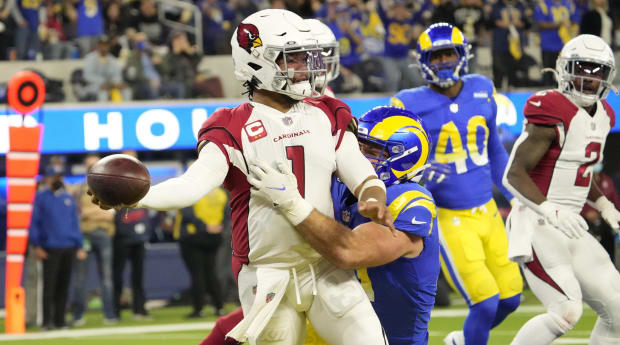The Cardinals did not lose Monday’s wild-card game to the Rams because Kyler Murray threw a pick-six while backed up in his own end zone in the second quarter, which put Los Angeles up three touchdowns with eight minutes remaining until halftime.
However, it is possible that the play was emblematic of why the Cardinals were picked apart by the Rams, and why the team lost five of its remaining six games to completely sour a 10–2 start that had them on a Super Bowl trajectory. It is possible that the play can tell us a little bit about everything, from their depth issues to their preparedness to the kind of subtle breadcrumbs they’ve left on film all year.
Let’s take the scene from the top. As Murray is backing up from the line of scrimmage into his shotgun depth, the Rams’ defense is actively talking. Aaron Donald says something to Greg Gaines. Linebacker Troy Reeder says something to Von Miller, getting a kind of subtle thumbs up. Donald then motions to Leonard Floyd. It’s clear they saw something familiar. It’s also clear they saw Chase Edmonds in the backfield, who is the lesser of the two Cardinals’ blocking backs (while not perfect, Pro Football Focus ranks James Conner as the best pass protection running back in the NFL, while Edmonds is toward the bottom third of the league).
While this could have been standard communication between players who are still getting to know one another, the precision with which they isolate, fool and pick apart the Cardinals’ offensive line in the ensuing seconds suggests otherwise.
The Cardinals are running a kind of standard multi-level play out of Kliff Kingsbury’s Air Raid playbook. Rondale Moore, the slot receiver, is going to act as the checkdown-type receiver and run a delayed, shallow route toward the sideline in an effort to keep Floyd from crashing the backfield. The two receivers to Moore’s right will both run deeper concepts.
It immediately becomes clear at the snap that Murray sees nothing from the deeper routes but continues to hold his gaze downfield. This has been somewhat of an issue for Murray despite his relatively speedy average snap to throw time. Last year, a professor at Kutztown University put together a matrix of quarterbacks who created the most pressure for themselves. Murray was among the most significant offenders. He also seems to dislike checkdown passes in certain situations and is middle-of-the-road in terms of short to medium range passing, despite its obvious benefits (Justin Herbert, Tom Brady and Aaron Rodgers, for example, seem to hold the checkdown and checkdown-related passes sacrosanct).
So, a convergence of two separate events happens.
Up front, the Cardinals’ offensive line gets completely flummoxed. Donald charges at the right side of Arizona's front and then backpedals into a kind of zone coverage stance. The hesitation caused two of the six people tasked with protecting Murray to basically freeze and take themselves out of the play. Gaines comes from the right side of the line and smashes his way underneath Donald and works his way toward those two frozen Cardinals defenders. At one point, if you freeze the play quickly enough, he is impacting four of the six Cardinals blockers on the play at once. One person, four offensive linemen. Donald then forces Cardinals guard Justin Pugh to basically play preventative, basketball-style defense ensuring that he won’t charge back into the backfield. Meanwhile, Miller has a one-on-one matchup with the left tackle—again, at the goal line—and Reeder has a one-on-one matchup against Edmonds, who throws an ineffective cut-type block that acts as a little more than a speed bump Reeder gets through and applies pressure to Murray.

Michael Chow/USA Today Network
The Cardinals’ condensed playbook lends itself to certain predictable route concepts, which gave a decimated Rams secondary a chance to lock on and stick to the deep receivers and force Murray to hang in the pocket. Murray’s aversion to taking the checkdown throw as it developed—something I’ve heard offensive coordinators evangelize for young quarterbacks, and, in pointing them toward Tom Brady’s penchant for quick checkdowns, manage to convert most of them—keeps him in the pocket even longer. There are a few instances of him passing up open checkdowns during the last Cardinals-Rams matchup as well. Murray had one of the longer snap to throw times in the NFL that week during his final regular season matchup with the Rams. In the first half of Monday’s game, Murray’s snap-to-throw time was almost a full second over his season average, and obviously a career worst mark.
The result is a panicked, last-minute attempt at salvaging the checkdown to Moore, which is obviously picked off and returned for a touchdown.
It was a moment that doesn’t take away for one moment how spectacular of a player Murray is, and how he would have been an MVP frontrunner this year had it not been for an injury. It doesn’t take away from the fact that Arizona has an impressive collection of skill position players and that, when DeAndre Hopkins is healthy, they pose a serious threat having mastered the condensed playbook. It doesn’t make their overall offensive theory a bad one, just a vulnerable one that raises important questions.
If the quick throw is so vital to the Air Raid, why hasn’t Kingsbury cemented it into Murray’s brain that Moore, in open space, at a dangerous part of the field, should get the ball the second he flashes? Why isn’t Murray being given myriad quick throw options against a team that seems to give him so much trouble in that department? And, how did the offensive line struggle so badly against what looked like simulated pressure? How did a defense with essentially no secondary outside of Jalen Ramsey force a potential MVP candidate quarterback to play right into their hands?
We know the quarterback isn't going anywhere. We don't know who is stepping up to answer for these questions.







